The first rule of Fight Clause is: You do not talk about Fight Clause.
Why not take a stroll on over here for links to see what the rest of the HoHoDooDa doodlers are doing.
Oh, and if you are wondering what the heck HoHoDooDa is, check this out.
The first rule of Fight Clause is: You do not talk about Fight Clause.
Why not take a stroll on over here for links to see what the rest of the HoHoDooDa doodlers are doing.
Oh, and if you are wondering what the heck HoHoDooDa is, check this out.
This past 5 July was Daniel Mendoza’s 250th birthday. Or was it? Most biographical sources say that Mendoza was born in 1764. The Encyclopedia Britannica, the Encyclopedia Judaica, Chambers Biographical Dictionary, and the Encyclopedia of World Biography all give 1764 for Mendoza’s year of birth, as do the the websites of the International Boxing Hall of Fame, the International Jewish Hall of Fame, WorldCat, and Wikipedia. The blue plaque on the house in Bethnal Green where Mendoza lived states that he was born in 1764. Indeed, Mendoza’s own memoirs claim that he was born on 5 July 1764.
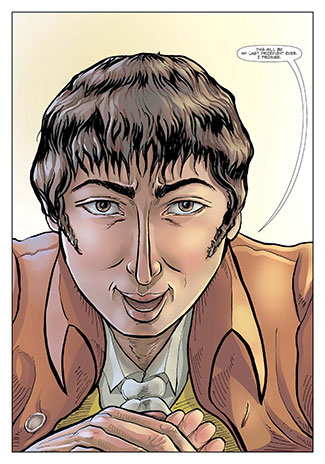
But the records of the Spanish and Portuguese Synagogue at Bevis Marks in London indicate that Mendoza was actually born in 1765. Thanks to the work of Lewis Edwards, who reported his findings in a lecture to the Jewish Historical Society of England in 1938, and whose paper was subsequently published in the Transactions of that society, we know that the Mendoza was circumcised on 12 July 1765, 249 years ago today. Jewish law requires infant boys to be circumcised on the eighth day after birth, and this would suggest a birth date of 4 July 1765. (Edwards writes that “we must take the date of birth to have been 5 July 1765,” but in that case Mendoza would only have been seven days old when he was circumcised, which would have violated Jewish law.) It would be quite a coincidence if another Daniel Mendoza had been born on 4 July 1765, and our Daniel Mendoza, whose family belonged to the same synagogue, had been missing from the circumcision records of the previous year. It is equally unlikely that Mendoza would have been circumcised at the age (almost exactly) of one year. Moreover, Edwards consulted the records of the Grand Lodge of Freemasons and found that “Daniel Mendoza, tobacconist, of Bethnal Green, aged 22,” was initiated into the society at some time between 29 October 1787 and 12 February 1788. We know from his memoirs that Mendoza had worked in a tobacconist’s shop between 1782 and 1787, and letters he wrote to the newspapers in 1788 gave his address as “Paradise-Row, Bethnal Green.” So it is reasonable to assume that the new initiate was Daniel Mendoza the pugilist.
Is it possible that Mendoza was mistaken about his own birth date? This seems unlikely, since if he knew he was 22 in late 1787 or early 1788 when he registered with the Freemasons, he should have known he was born in 1765. A printer’s error is more likely the cause. One can easily imagine a printer, or an apprentice, switching the type and accidently entering his “5” after “July” and placing his “4” after “176,” thereby changing 4 July 1765 to 5 July 1764. Whatever the reason for the error, once it was made it was bound to be repeated. When reporting on Mendoza’s death in September 1836, the Morning Post wrote that the boxer “had reached his 73rd year,” as did Bell’s Life in London and Sporting Chronicle, when in fact he died in his 72nd. And the proliferation of this false information in the years following Mendoza’s death made made it “common knowledge.” Despite Edwards’s careful research, most of the people who have written about Mendoza in the last three quarters of a century have repeated the earlier mistake.
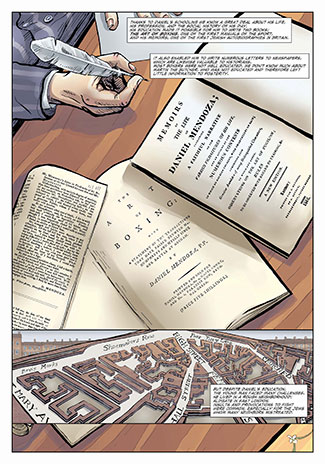 Why does any of this matter? What difference does it make if Mendoza was 21 and not 22 when he defeated Martin the Butcher? Probably not much. Am I being pedantic by trying to determine the exact date of Mendoza’s birth? Not entirely. If historians are less than rigorous with details that “don’t matter,” we are likely to be lax when they do matter. Moreover, there is a case to be made that Mendoza’s birth year does matter. After all, we are dealing with a commemoration. The bicentennary of the French Revolution was commemorated in 1989, and any attempt to move it up to 1988 would have been seen as misguided. Similarly, Americans would have balked at the suggestion that they celebrate the bicentennial of the Declaration of Independence in 1975 rather than 1976. The birth of a famous boxer is in a different category of world-historical importance, to be sure, but commemoration is commemoration, and it obeys certain rules. Centuries and half-centuries are more important than decades, which take precedence over individual years. How would you feel if you went to celebrate your grandmother’s 100th birthday only to find out when you arrived at the party that she was 99 (and that her birthday was the previous day)? You would wish her well, but somehow it wouldn’t be the same.
Why does any of this matter? What difference does it make if Mendoza was 21 and not 22 when he defeated Martin the Butcher? Probably not much. Am I being pedantic by trying to determine the exact date of Mendoza’s birth? Not entirely. If historians are less than rigorous with details that “don’t matter,” we are likely to be lax when they do matter. Moreover, there is a case to be made that Mendoza’s birth year does matter. After all, we are dealing with a commemoration. The bicentennary of the French Revolution was commemorated in 1989, and any attempt to move it up to 1988 would have been seen as misguided. Similarly, Americans would have balked at the suggestion that they celebrate the bicentennial of the Declaration of Independence in 1975 rather than 1976. The birth of a famous boxer is in a different category of world-historical importance, to be sure, but commemoration is commemoration, and it obeys certain rules. Centuries and half-centuries are more important than decades, which take precedence over individual years. How would you feel if you went to celebrate your grandmother’s 100th birthday only to find out when you arrived at the party that she was 99 (and that her birthday was the previous day)? You would wish her well, but somehow it wouldn’t be the same.
So let’s find some fitting way to celebrate the 250th anniversary of Mendoza’s birth, but let’s do it next year, and on the 4th of July.
Ronald Schechter is Associate Professor of History at the College of William and Mary. He is the author of Obstinate Hebrews: Representations of Jews in France, 1715-1815 (Berkeley: University of California Press, 2003) and translator of Nathan the Wise by Gotthold Ephraim Lessing with Related Documents (Boston and New York: St. Martin’s Press, 2004). He is author of the graphic history Mendoza the Jew: Boxing, Manliness, and Nationalism, illustrated by Liz Clarke. His research interests include Jewish, French, British, and German history with a focus on the eighteenth and nineteenth centuries.
Subscribe to the OUPblog via email or RSS.
Subscribe to only history articles on the OUPblog via email or RSS.
Images from Mendoza the Jew: Boxing, Manliness, and Nationalism, illustrated by Liz Clarke. Do not use without permission.
The post Daniel Mendoza: born on the 4th of July (249 years ago) appeared first on OUPblog.
Mary-Todd, Jonathan. 2014. The Giant. Minneapolis: Lerner.
(Advance Reader Copy)
The Giant is the latest in the Bareknuckle series featuring young fighters in New York City, circa 1870. Luc is the giant - a hulking, kind, illiterate young man who easily wins all of his bareknuckle fights. The money he earns at the local fight club provides only shabby room and board with any small profit going to Mr. Chilton, the man who brought him from Canada to New York. Life, however, is better than it was in Quebec; and Luc is not unhappy until a stranger with boxing kangaroos joins up with Mr. Chilton. Thoughtful and kind, Luc is uncomfortable seeing the kangaroo, Genghis, forced to fight amidst the drunken crowds at the seedy Woodrat Club.
One day in Quebec, when Luc was chopping wood, a few of the others dragged a man into camp. The man had been hunting for furs when snow began to fall, covering some of the traps he'd set. Soon the man stepped into one of them. The older men brought him indoors before he could bleed out, but it took five of them together to pry the trap loose.Unaccustomed to making decisions on his own, Luc's conscience finally compels him to act independently.
Genghis's fight the night before worked like a trap on Luc. Each thought of it was painful, but he could not shake the memory. He had felt the drain throughout the morning, and he felt it in his room.
Let me begin with a confession. I used to be a snob when it came to comics. I learned to read circa 1970 and even though my first books were illustrated, there was something about the comic format – the words confined to speech and thought bubbles and the scenes subdivided into frames – that felt less than serious. The only time I remember being allowed to buy comic books was when I had just been to the doctor’s office. Comics were a reward and a comfort for putting up with a cold or the flu or an injection. They were to literature what ice cream was to cuisine. I know I wasn’t alone, and that there are cultural-historical reasons why the adults of my childhood were suspicious of comics. The form itself represented an independent youth culture with its hints of rebelliousness, idleness, sexuality and delinquency, even if I was only reading Richie Rich (an establishment comic if ever there was one) or Caspar the Friendly Ghost.
I would like to say that I came to appreciate the graphic form when I was living in Paris in the early 1990s and when imaginative, beautiful, and thought-provoking bandes-dessinées graced the shelves of serious bookstores on the Boulevard Saint-Germain. That would make me sound sophisticated and open-minded. Unfortunately it wouldn’t be true. I stayed away from that section of the bookstore and concentrated on imageless books, preferably thick in-octavo volumes with pages no larger than six by eight inches.
In the late 90s I was given Art Spiegelman’s Maus as a gift, but I left it on a shelf until my teenage son read it about a decade later and recommended it to me. I then read it and was moved, as many readers have been, but I had misgivings about a book that represented the Holocaust as a kind of fable with animals playing the roles. In retrospect I believe it was the form of the comic book itself that troubled me most. How could the memory of Holocaust victims be honored with something as profane as a comic book? Again, I was still in the thrall of a culture that had an irrational prejudice against illustrated stories divided into (usually) six frames per page and with text contained in speech and thought bubbles. A comic book was profane because, well, it was a comic book.
So when a representative at Oxford University Press for Virginia, Maryland, and Washington, D.C. gave me a copy of a “graphic history” called Abina and the Important Men, written by Trevor Getz and illustrated by Liz Clarke, I wasn’t necessarily the best candidate for adopting the book. I flipped through it and couldn’t help being gripped by the images of a young woman from the Gold Coast who had taken her employer to court in 1876 for illegally enslaving her, but I placed it on my shelf along with the many other books I had received from publishers. I would think about it, I told myself, but then stopped thinking about it. It wasn’t until I ran into my learned friend Mack Lundy that I thought about the book again. Mack said, “Have you seen a book called Abina and the Important Men? I just picked it up at the College bookstore yesterday and it’s amazing.” Mack is an IT specialist at my College library and is not required to read college history textbooks as part of his job, and he even wrote about the book on his Africa-themed blog. This made his endorsement of the book all the more persuasive.
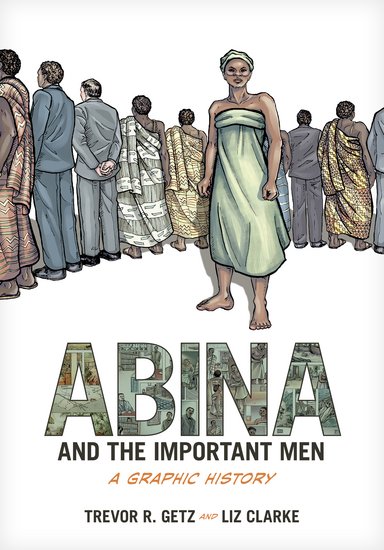
It happened to be the time of year when I had to choose books to adopt for my courses the following semester, so I read Abina. “My students will love this,” I thought. (Imagine a college professor with this thought written out in a “thought bubble.”) There was something condescending in that thought. I could have chosen a real book to assign, the sort of book I would love, but as a favor to my students I would give them a break and assign a comic book.
As it turned out, Abina was quite challenging, even more challenging than many of the convential-form books I otherwise assign. This was not only because of the complex subject matter, involving such themes as global trade, imperialism, diplomacy, and human rights, but because it thematized the interpretive work historians do when making sense of historical evidence. In other words, it provided a lesson in historical methodology, something few undergraduate course books do. It accomplished this in two ways. First, it included the court transcript of Abina’s case. This gave students the opportunity to compare the primary source with the secondary source (in this case the graphic history). But the second way was inherent to the graphic form itself. The color pictures, the expressions on the faces, the gestures, the dialogue and the thoughts imputed to the characters made it very clear that the history being told was a work of the imagination.
Historians are sometimes reluctant to discuss the role of the imagination in the production of their work, especially when speaking to students who (it might be feared) could mistake imagination for wholesale invention. But students benefit from the knowledge that historians do not simply report what they find in the archives. They give it a form, choose some elements and leave others out, and tell a story. They do this even when they choose an analytical approach to exposition. The narrative aspect of history-writing is graphically clear in the graphic form.
Ronald Schechter is Associate Professor of History at the College of William and Mary. He is the author of Obstinate Hebrews: Representations of Jews in France, 1715-1815 (Berkeley: University of California Press, 2003) and translator of Nathan the Wise by Gotthold Ephraim Lessing with Related Documents (Boston and New York: St. Martin’s Press, 2004). He is author of the graphic history Mendoza the Jew: Boxing, Manliness, and Nationalism, illustrated by Liz Clarke. His research interests include Jewish, French, British, and German history with a focus on the eighteenth and nineteenth centuries.
Subscribe to the OUPblog via email or RSS.
Subscribe to only history articles on the OUPblog via email or RSS.
The post Writing a graphic history: Mendoza the Jew appeared first on OUPblog.
The illustration of a graphic history begins with the author’s script. There are two aspects to turning that script into artwork. It’s both a story, calling for decisions to be made about the best way to present the narrative visually, and a history, rooted in fact and raising questions about what the places and people (and their furniture and transportation and utensils) would actually have looked like.

A sketch of Esther Mendoza, wife of Daniel Mendoza. Courtesy of Liz Clarke. Used with permission.
It’s unlikely that we’ll find perfect answers to all of these questions, particularly in a pre-photography age like the late 18th century, when Daniel Mendoza was at the height of his boxing career. Some subjects offer a wealth of images. Some, like a number of the places Mendoza frequented in London, still exist today. I was able to work from current photographs of locations including Mendoza’s house in Paradise Row, the cemetery where he is buried, and the exterior of the White Hart Inn. We had several images of Mendoza himself to refer to, thanks to his celebrity status. We knew what he looked like at different points in his life, how tall he was and how much he weighed. We knew about his fighting style from newspaper reports, artwork, and from his own instructional writing.
However, other subjects may not have been recorded in an image or even in a written description at the time. If records were made, they may not have survived. This means we have to cast the net wider. There are many sources of general information available that allow a lateral approach — records of people and places with shared characteristics, surviving artefacts and garments, artwork and documents from the time. There was nothing definite to work from in the case of Mendoza’s wife Esther, but we could ask what a woman like Mendoza’s wife would have looked like. How would a woman similar in age, class, and religion to Esther have dressed and worn her hair? We could then blend fact and imagination to arrive at a concept sketch of Esther, which allowed us to agree on how we would depict her.
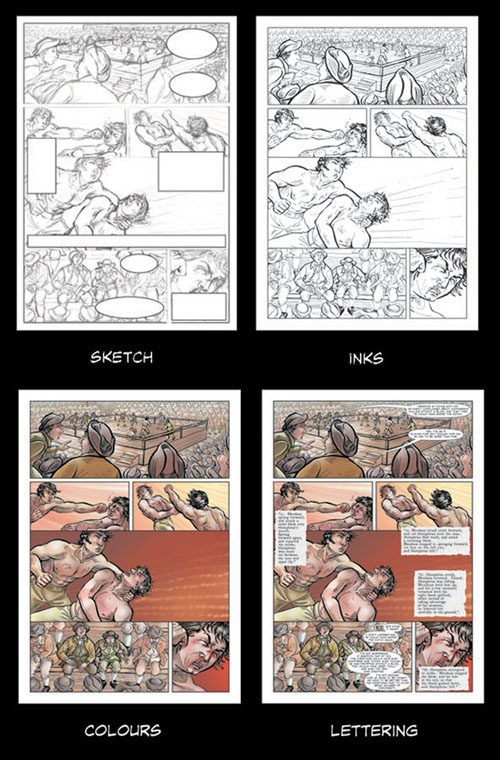
A page from Mendoza the Jew, showing the process from the sketch stage to the final piece. Courtesy of Liz Clarke. Used with permission.
Once we have enough information, each page is planned in detail. I’ll decide on the composition of the whole page, and of the contents of each panel on the page. There are choices to make about viewpoint (for example, if the scene is going to be presented from a low angle, looking up at it, or a high angle, looking down on it, which creates two very different effects), how to draw attention to the pivotal point in the scene, the characters’ body language and expressions, if they aren’t already defined by the script, and how to convey the themes of the book. This layout sketch is the most important stage in the illustration of a page.
Once the author has approved the sketch, I draw it in ink as line art and prepare this to be coloured digitally. Colour and the nature and direction of the light can also contribute to the storytelling. For example, the desaturated colours at the beginning of an exchange between Mendoza and Humphries, when Mendoza is not at his best, gradually become brighter and warmer by the end of the scene, as their verbal sparring restores Mendoza’s fighting spirit. The text comprising the narrative and dialogue is added to the art, and text boxes and speech bubbles are fitted to it. For Mendoza the Jew, we decided to use three different fonts. Two fonts with some resemblance to typefaces from the time period represented quotes from Mendoza’s autobiography and from a newspaper report of Mendoza’s match against Humphries in Doncaster, distinguishing the author’s words from Mendoza’s, and those of the reporter.
As an artist, illustrating a graphic history, as opposed to a work of fiction, has some unique rewards as well as challenges. There’s an awareness that these were real individuals and events, and it always feels like a privilege to be telling their stories.
Liz Clarke is an illustrator based in Cape Town, South Africa. Her artwork has appeared in magazines, games and books, including Abina and the Important Men: A Graphic History by Trevor R. Getz and Mendoza the Jew, Boxing, Manliness, and Nationalism: A Graphic History by Ronald Schechter.
Subscribe to the OUPblog via email or RSS.
Subscribe to only history articles on the OUPblog via email or RSS.
The post Illustrating a graphic history: Mendoza the Jew appeared first on OUPblog.
With just over a week to go until Christmas, many of us are no doubt looking forward to the holidays and a few days off work. For those working on the first edition of the Oxford English Dictionary, however, writing the history of the language sometimes took precedence over a Christmas break.

Christmas leave in the UK today centres around a number of bank holidays, so called because they are days when, traditionally, banks closed for business. Before 1834, the Bank of England recognized about 33 religious festivals but this was reduced to just four in 1834 – Good Friday, 1 May, 1 November, and Christmas Day. It was the Bank Holidays Act of 1871 that saw bank holidays officially introduced for the first time. These designated four holidays in England, Wales, and Northern Ireland — Easter Monday, Whit Monday, the first Monday in August, and Boxing Day. Good Friday and Christmas Day were seen as traditional days of rest so did not need to be included in the Act. Scotland was granted five days of holiday — New Year’s Day, Good Friday, the first Monday in May, the first Monday in August, and Christmas Day.
So when James Murray took over as editor of the OED in 1879, Christmas Day was an accepted holiday across the whole of the UK, Boxing Day a bank holiday everywhere except Scotland, and New Year’s Day a bank holiday only in Scotland. Yet this didn’t stop editors and contributors toiling away on dictionary work on all three of those dates.
Here is the first page of a lengthy letter to James Murray from fellow philologist Walter Skeat, written on Christmas Day, 1905. Skeat does at least start his letter with some seasonal greetings and sign off “in haste”, but talks at length about the word pillion in between! There are at least two other letters in the OED archives written on Christmas Day – a letter from W. Boyd-Dawkins in 1883 about the word aphanozygous (apparently the cheekbones being invisible when the skull is viewed from above, who knew?), and another from R.C.A. Prior about croquet in 1892.

Written on Boxing Day, 1891, this letter to James Murray is from Richard Oliver Heslop, author of Northumberland Words. After an exchange of festive pleasantries, Oliver Heslop writes about the word corb as a possible misuse for the basket known as a corf, clearly a pressing issue whilst eating turkey leftovers! Many other Boxing Day letters reside in the OED archives, amongst them a 1932 letter to OUP’s Kenneth Sisam from editor William Craigie concerning potential honours in the New Year Honours list following completion of the supplement to the OED.

Speaking of New Year, here is a “useless” letter to James Murray from OUP’s Printer Horace Hart, written on New Year’s Day, 1886. Although not an official holiday in Oxford at that time, this letter provides a nice opportunity for discussing the etymology of the term Boxing Day. The first weekday after Christmas Day became known as Boxing Day as it was the day when postmen, errand-boys, and servants of various kinds expected to receive a Christmas box as a monetary reward for their services during the previous year. This letter talks about baksheesh, a word used in parts of Asia for a gratuity or tip.

In case you’re wondering, New Year’s Day was granted as an additional bank holiday in England, Wales, and Northern Ireland in 1974, as was Boxing Day in Scotland (and 2 January from 1973). So the whole of the UK now gets all three as official days of leave in which to enjoy the festive season.
This article originally appeared on the OxfordWords blog.
Beverley Hunt is Archivist for the Oxford English Dictionary but will not be archiving on Christmas Day, Boxing Day, or New Year’s Day.
If you’re feeling inspired by the words featured in today’s blog post, why not take some time to explore OED Online? Most UK public libraries offer free access to OED Online from your home computer using just your library card number. If you are in the US, why not give the gift of language to a loved-one this holiday season? We’re offering a 20% discount on all new gift subscriptions to the OED to all customers residing in the Americas.
Subscribe to the OUPblog via email or RSS.
Subscribe to only language, lexicography, word, etymology, and dictionary articles on the OUPblog via email or RSS.
Subscribe to the OxfordWords blog via RSS.
The post Don’t bank on it appeared first on OUPblog.
 |
| ||||||||||
 Working in popular culture as an academic can mean turning one’s guilty pleasures into an object of study. So it was for me when I read the 2010 re-release of DC’s 1978 comic, Superman vs. Muhammad Ali (written by Dennis O’Neil and Neal Adams). Along with the Rumble in the Jungle (his 1974 fight against George Foreman in Kinshasa, Zaire, in which he regained the Heavyweight title) and the Thrilla in Manilla (his 1975 fight against in the Philippines against Joe Frazier), Muhammad Ali’s fight against Superman would surely rank as a highpoint in his 1970s boxing career. I wasn’t reading this for its classical content.
Working in popular culture as an academic can mean turning one’s guilty pleasures into an object of study. So it was for me when I read the 2010 re-release of DC’s 1978 comic, Superman vs. Muhammad Ali (written by Dennis O’Neil and Neal Adams). Along with the Rumble in the Jungle (his 1974 fight against George Foreman in Kinshasa, Zaire, in which he regained the Heavyweight title) and the Thrilla in Manilla (his 1975 fight against in the Philippines against Joe Frazier), Muhammad Ali’s fight against Superman would surely rank as a highpoint in his 1970s boxing career. I wasn’t reading this for its classical content.
Ali fights Superman in the Fortress of Solitude (not in a celebrity-filled Madison Square Gardens, as the cover implies), in order to determine who will represent Earth against the champion of the alien Scrugg invaders, Hun’Ya. Though not superpowered, Ali represents Earth and defends it from the Scruggs in an interstellar boxing match, held in space, where – I kid you not – the goddess Athena appears and serves as a guest referee.
Now I’m pretty certain that this intrusion of the ancient world into a moment of intergalactic conflict is an unexpected turn in the story for the comic’s readers. Within the narrative, Lois Lane’s words encapsulate the reader’s sense of disruption: “What we’re witnessing here is something totally unexpected by anyone!! A strange, ethereal — though definitely feminine form — is slowly descending to the center of the ring!” (p. 43.1). Daily Planet Editor Perry White’s clichéd exclamation, “Great Caesar’s ghost!”, leads to Athena’s declaration of intergalactic syncretism: “I did observe the various Caesars of years gone by. I am… Pallas Athene!” (44.1) – to which the comic’s editor attaches the footnote, “the Greek goddess of wisdom.” Rat’Lar, leader of the Scruggs, is impressed: “To us she is Aurenim…spirit of courage” (44.2); “I am many things to many people,” is the golden goddess’s enigmatic reply.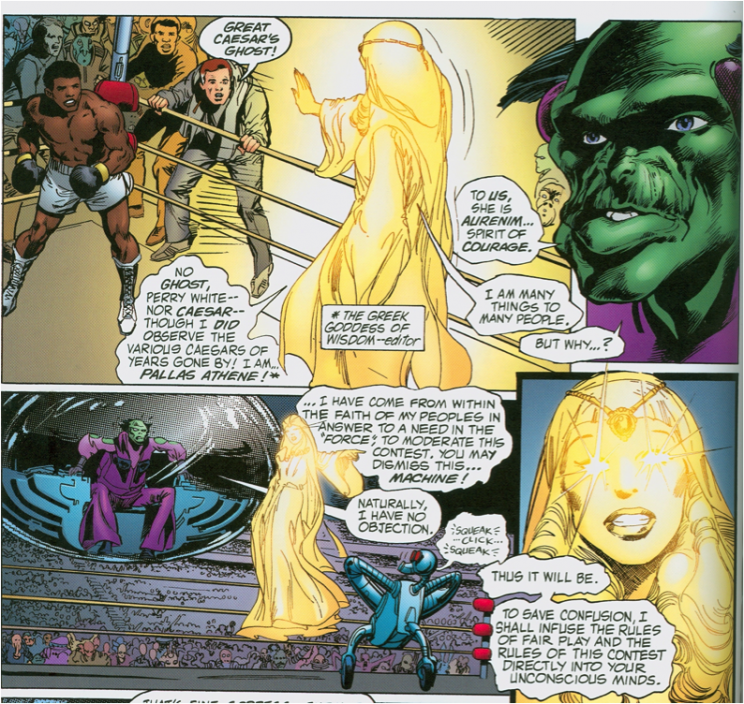
The shared religious inheritance of Scruggs and humans means that both sides accept the floating goddess’s impartial arbitration: “I have come from within the faith of my peoples to answer a need in the ‘force’, to moderate this contest,” she declares, as she infuses the rules of fair play directly into the combatants’ unconscious minds (44.3-4l it is hard not to see a reference to the Force in 1977’s Star Wars). Earth’s fate is given a transcendent dimension infused with wisdom, courage, and (for those who know more about Athena than the editor’s footnote) a willingness to fight in the frontline of battle (whether as Athene Promachos, or, as a goddess of victory, Athene Nike). The Hellenizing spelling used – �
I had a joyous day earlier this week, donning my boxing gloves and pounding away at the heavy bag in the back corner of my gym. Bad Moon Rising was blasting from my iPod; I was wearing pink and feeling strong; the more I hit the bag, the more I felt as if I was going to lift off the ground and fly.
The Taos Poetry Circus ended its run after 22 years in 2003. The World Poetry Bout Association, which ran the World Heavyweight Championship Poetry Bout ("The Main Event") during the circus, disbanded. But remnants of the circus exist, including video footage of the 10-round bouts, and this archived article from the NY Times: Bouts of Poetry (the Stress is on Beat,) published June 21, 1994.
"...the circus included readings by several American Indians, like Sherman Alexie, a 27-year-old poet from Spokane, Wash., of the Coeur d'Alene tribe. In a bout on June 9, he read several works, including "Song," which speaks of adolescence on the reservation:
I remember all your names, Indian girls I loved, Dawn, Loretta, Michelle, Jana, Go-Go, Lulu, all of you Spokane Indian princesses who never asked me to slow dance
To the music
That always found its way
Into the tribal school."
Poor Santa! Cute.